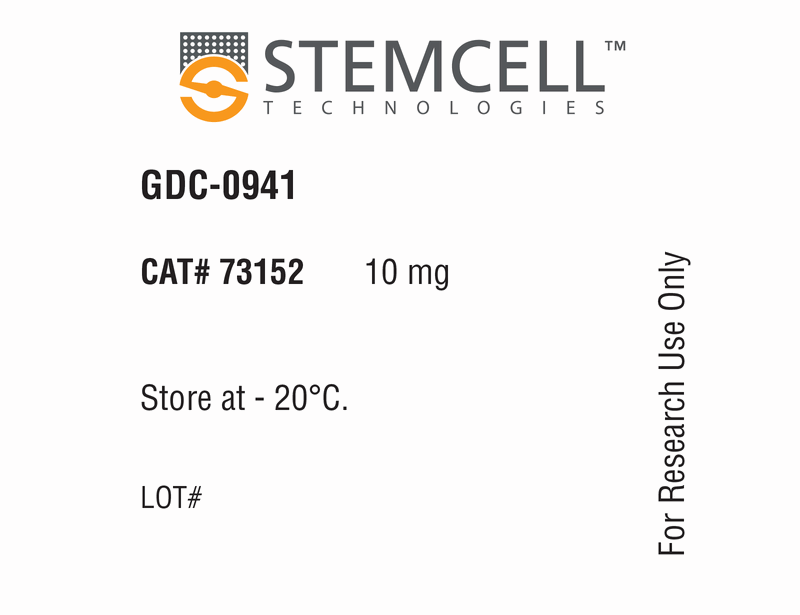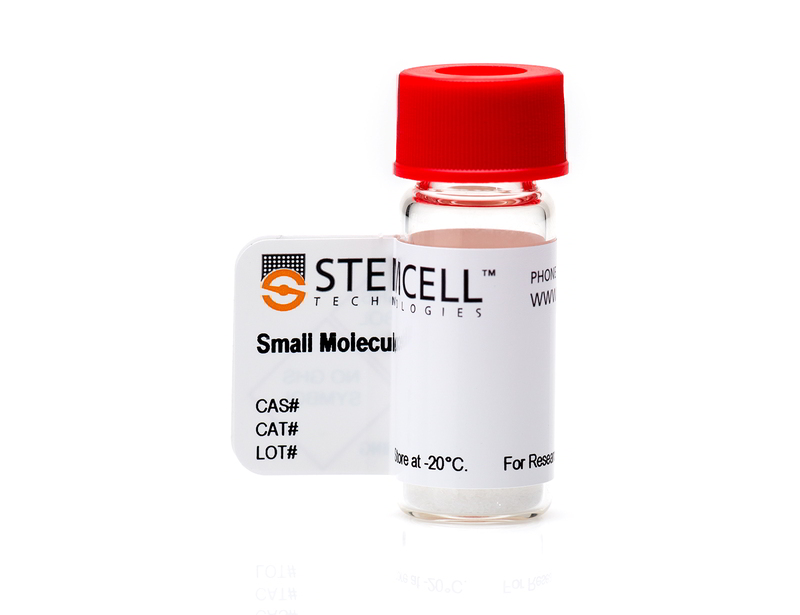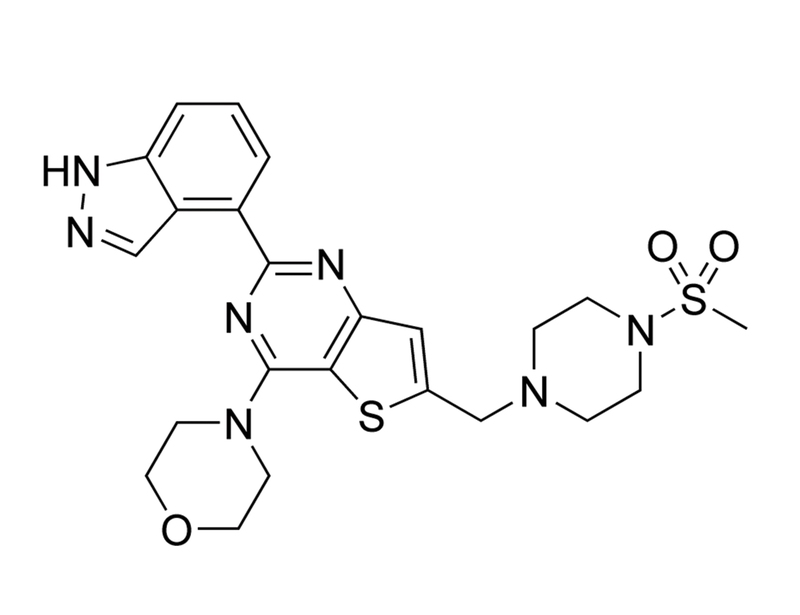GDC-0941
PI3K/AKT pathway inhibitor; Inhibits Class I PI3Ks
概要
GDC-0941 is an inhibitor of phosphatidylinositol-4,5-bisphosphate 3-kinase (PI3K). It inhibits class I catalytic subunits of PI3K p110α, β, δ, and γ with IC₅₀ values of 3, 33, 3, and 75 nM, respectively, by binding near the ATP binding pocket (Folkes et al.; Berndt et al.). It shows selectivity against class II, III, and IV PI3K isoforms as well, but with lower efficacy; for example, it inhibits phosphatidylinositol-4-phosphate 3-kinase C2 domain subunit β (C2β, Class II) and mammalian target of rapamycin (mTOR, Class IV) in the high nanomolar range and most others in the micromolar range (Folkes et al.).
CANCER RESEARCH
· Inhibits proliferation of multiple cancer cell lines, such as U87MG (glioblastoma), PC3 (prostate) and MDA-MB-361 (breast) lines, in vitro and in mouse xenograft models (Folkes et al.; Raynaud et al.; O’Brien et al.).
· Induces apoptosis and inhibits xenograft tumor growth in combination with a MAP/ERK kinase (MEK) inhibitor GDC-0973 (Hoeflich et al.).
CANCER RESEARCH
· Inhibits proliferation of multiple cancer cell lines, such as U87MG (glioblastoma), PC3 (prostate) and MDA-MB-361 (breast) lines, in vitro and in mouse xenograft models (Folkes et al.; Raynaud et al.; O’Brien et al.).
· Induces apoptosis and inhibits xenograft tumor growth in combination with a MAP/ERK kinase (MEK) inhibitor GDC-0973 (Hoeflich et al.).
Alternative Names
GNE 0941; Pictilisib; Pictrelisib
Cell Type
Cancer Cells and Cell Lines
Species
Human, Mouse, Rat, Non-Human Primate, Other
Area of Interest
Cancer Research
CAS Number
957054-30-7
Chemical Formula
C₂₃H₂₇N₇O₃S₂
Molecular Weight
513.6 g/mol
Purity
≥ 98%
Pathway
PI3K/AKT
Target
PI3K
技术资料
| Document Type | 产品名称 | Catalog # | Lot # | 语言 |
|---|---|---|---|---|
| Product Information Sheet | GDC-0941 | 73152 | All | English |
| Safety Data Sheet | GDC-0941 | 73152 | All | English |
数据及文献
Publications (6)
Clinical cancer research : an official journal of the American Association for Cancer Research 2015
First-in-human phase I study of pictilisib (GDC-0941), a potent pan-class I phosphatidylinositol-3-kinase (PI3K) inhibitor, in patients with advanced solid tumors.
Abstract
Abstract
PURPOSE: This first-in-human dose-escalation trial evaluated the safety, tolerability, maximal-tolerated dose (MTD), dose-limiting toxicities (DLT), pharmacokinetics, pharmacodynamics, and preliminary clinical activity of pictilisib (GDC-0941), an oral, potent, and selective inhibitor of the class I phosphatidylinositol-3-kinases (PI3K). PATIENTS AND METHODS: Sixty patients with solid tumors received pictilisib at 14 dose levels from 15 to 450 mg once-daily, initially on days 1 to 21 every 28 days and later, using continuous dosing for selected dose levels. Pharmacodynamic studies incorporated (18)F-FDG-PET, and assessment of phosphorylated AKT and S6 ribosomal protein in platelet-rich plasma (PRP) and tumor tissue. RESULTS: Pictilisib was well tolerated. The most common toxicities were grade 1-2 nausea, rash, and fatigue, whereas the DLT was grade 3 maculopapular rash (450 mg, 2 of 3 patients; 330 mg, 1 of 7 patients). The pharmacokinetic profile was dose-proportional and supported once-daily dosing. Levels of phosphorylated serine-473 AKT were suppressed textgreater90% in PRP at 3 hours after dose at the MTD and in tumor at pictilisib doses associated with AUC textgreater20 htextperiodcenteredμmol/L. Significant increase in plasma insulin and glucose levels, and textgreater25% decrease in (18)F-FDG uptake by PET in 7 of 32 evaluable patients confirmed target modulation. A patient with V600E BRAF-mutant melanoma and another with platinum-refractory epithelial ovarian cancer exhibiting PTEN loss and PIK3CA amplification demonstrated partial response by RECIST and GCIG-CA125 criteria, respectively. CONCLUSION: Pictilisib was safely administered with a dose-proportional pharmacokinetic profile, on-target pharmacodynamic activity at dose levels ≥100 mg and signs of antitumor activity. The recommended phase II dose was continuous dosing at 330 mg once-daily.
Cancer research 2012
Intermittent administration of MEK inhibitor GDC-0973 plus PI3K inhibitor GDC-0941 triggers robust apoptosis and tumor growth inhibition.
Abstract
Abstract
Combinations of MAP/ERK kinase (MEK) and phosphoinositide 3-kinase (PI3K) inhibitors have shown promise in preclinical cancer models, leading to the initiation of clinical trials cotargeting these two key cancer signaling pathways. GDC-0973, a novel selective MEK inhibitor, and GDC-0941, a class I PI3K inhibitor, are in early stage clinical trials as both single agents and in combination. The discovery of these selective inhibitors has allowed investigation into the precise effects of combining inhibitors of two major signaling branches downstream of RAS. Here, we investigated multiple biomarkers in the mitogen-activated protein kinase (MAPK) and PI3K pathway to search for points of convergence that explain the increased apoptosis seen in combination. Using washout studies in vitro and alternate dosing schedules in mice, we showed that intermittent inhibition of the PI3K and MAPK pathway is sufficient for efficacy in BRAF and KRAS mutant cancer cells. The combination of GDC-0973 with the PI3K inhibitor GDC-0941 resulted in combination efficacy in vitro and in vivo via induction of biomarkers associated with apoptosis, including Bcl-2 family proapoptotic regulators. Therefore, these data suggest that continuous exposure of MEK and PI3K inhibitors in combination is not required for efficacy in preclinical cancer models and that sustained effects on downstream apoptosis biomarkers can be observed in response to intermittent dosing.
Clinical cancer research : an official journal of the American Association for Cancer Research 2010
Predictive biomarkers of sensitivity to the phosphatidylinositol 3' kinase inhibitor GDC-0941 in breast cancer preclinical models.
Abstract
Abstract
PURPOSE: The class I phosphatidylinositol 3' kinase (PI3K) plays a major role in proliferation and survival in a wide variety of human cancers. A key factor in successful development of drugs targeting this pathway is likely to be the identification of responsive patient populations with predictive diagnostic biomarkers. This study sought to identify candidate biomarkers of response to the selective PI3K inhibitor GDC-0941. EXPERIMENTAL DESIGN: We used a large panel of breast cancer cell lines and in vivo xenograft models to identify candidate predictive biomarkers for a selective inhibitor of class I PI3K that is currently in clinical development. The approach involved pharmacogenomic profiling as well as analysis of gene expression data sets from cells profiled at baseline or after GDC-0941 treatment. RESULTS: We found that models harboring mutations in PIK3CA, amplification of human epidermal growth factor receptor 2, or dual alterations in two pathway components were exquisitely sensitive to the antitumor effects of GDC-0941. We found that several models that do not harbor these alterations also showed sensitivity, suggesting a need for additional diagnostic markers. Gene expression studies identified a collection of genes whose expression was associated with in vitro sensitivity to GDC-0941, and expression of a subset of these genes was found to be intimately linked to signaling through the pathway. CONCLUSION: Pathway focused biomarkers and the gene expression signature described in this study may have utility in the identification of patients likely to benefit from therapy with a selective PI3K inhibitor.
Nature chemical biology 2010
The p110 delta structure: mechanisms for selectivity and potency of new PI(3)K inhibitors.
Abstract
Abstract
Deregulation of the phosphoinositide-3-OH kinase (PI(3)K) pathway has been implicated in numerous pathologies including cancer, diabetes, thrombosis, rheumatoid arthritis and asthma. Recently, small-molecule and ATP-competitive PI(3)K inhibitors with a wide range of selectivities have entered clinical development. In order to understand the mechanisms underlying the isoform selectivity of these inhibitors, we developed a new expression strategy that enabled us to determine to our knowledge the first crystal structure of the catalytic subunit of the class IA PI(3)K p110 delta. Structures of this enzyme in complex with a broad panel of isoform- and pan-selective class I PI(3)K inhibitors reveal that selectivity toward p110 delta can be achieved by exploiting its conformational flexibility and the sequence diversity of active site residues that do not contact ATP. We have used these observations to rationalize and synthesize highly selective inhibitors for p110 delta with greatly improved potencies.
Molecular cancer therapeutics 2009
Biological properties of potent inhibitors of class I phosphatidylinositide 3-kinases: from PI-103 through PI-540, PI-620 to the oral agent GDC-0941.
Abstract
Abstract
The phosphatidylinositide 3-kinase pathway is frequently deregulated in human cancers and inhibitors offer considerable therapeutic potential. We previously described the promising tricyclic pyridofuropyrimidine lead and chemical tool compound PI-103. We now report the properties of the pharmaceutically optimized bicyclic thienopyrimidine derivatives PI-540 and PI-620 and the resulting clinical development candidate GDC-0941. All four compounds inhibited phosphatidylinositide 3-kinase p110alpha with IC(50) textless or = 10 nmol/L. Despite some differences in isoform selectivity, these agents exhibited similar in vitro antiproliferative properties to PI-103 in a panel of human cancer cell lines, with submicromolar potency in PTEN-negative U87MG human glioblastoma cells and comparable phosphatidylinositide 3-kinase pathway modulation. PI-540 and PI-620 exhibited improvements in solubility and metabolism with high tissue distribution in mice. Both compounds gave improved antitumor efficacy over PI-103, following i.p. dosing in U87MG glioblastoma tumor xenografts in athymic mice, with treated/control values of 34% (66% inhibition) and 27% (73% inhibition) for PI-540 (50 mg/kg b.i.d.) and PI-620 (25 mg/kg b.i.d.), respectively. GDC-0941 showed comparable in vitro antitumor activity to PI-103, PI-540, and PI-620 and exhibited 78% oral bioavailability in mice, with tumor exposure above 50% antiproliferative concentrations for textgreater8 hours following 150 mg/kg p.o. and sustained phosphatidylinositide 3-kinase pathway inhibition. These properties led to excellent dose-dependent oral antitumor activity, with daily p.o. dosing at 150 mg/kg achieving 98% and 80% growth inhibition of U87MG glioblastoma and IGROV-1 ovarian cancer xenografts, respectively. Together, these data support the development of GDC-0941 as a potent, orally bioavailable inhibitor of phosphatidylinositide 3-kinase. GDC-0941 has recently entered phase I clinical trials.
Journal of medicinal chemistry 2008
The identification of 2-(1H-indazol-4-yl)-6-(4-methanesulfonyl-piperazin-1-ylmethyl)-4-morpholin-4-yl-thieno[3,2-d]pyrimidine (GDC-0941) as a potent, selective, orally bioavailable inhibitor of class I PI3 kinase for the treatment of cancer .
Abstract
Abstract
Phosphatidylinositol-3-kinase (PI3K) is an important target in cancer due to the deregulation of the PI3K/ Akt signaling pathway in a wide variety of tumors. A series of thieno[3,2-d]pyrimidine derivatives were prepared and evaluated as inhibitors of PI3 kinase p110alpha. The synthesis, biological activity, and further profiling of these compounds are described. This work resulted in the discovery of 17, GDC-0941, which is a potent, selective, orally bioavailable inhibitor of PI3K and is currently being evaluated in human clinical trials for the treatment of cancer.



